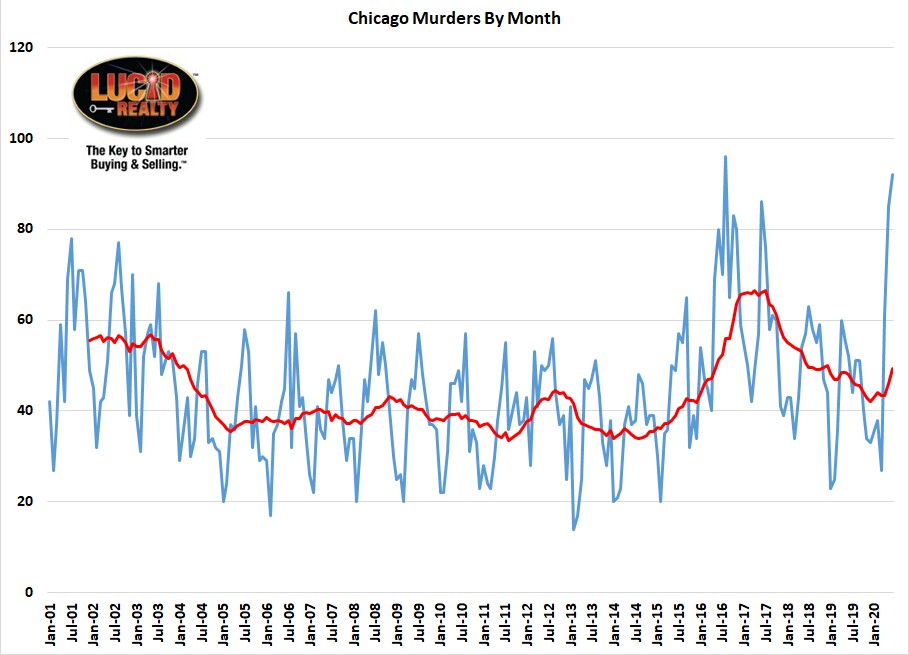A more current version of this post is available with Chicago murder data through June 2021.
You’ve probably heard that Chicago’s murder rate is on the rise. So I decided to check just how bad it is relative to the past. Going back to January 2001 (the earliest data I have access to) it’s clear that May and June of this year are outliers. June had 92 murders, which is getting pretty close to the record set in August 2016 when 96 people were killed. July is probably going to end up at the high end of the range also based on the preliminary data I’ve seen. Who knows what is going on but it’s conceivable that sitting at home with nothing to do, and possibly having no income, makes people want to kill someone.
As I’ve noted in the past there is a clear seasonality in the data. Apparently, when it’s cold outside you really have to hate someone to leave your home and kill them. Murders tend to peak in the warmer months of June – September. Is that because people get out of their homes more and run into more people? But then again we’re seeing this recent surge when more people are home supposedly.
Over the 12 month period ending in June there were 592 murders in Chicago, which is up from 563 murders last year at this time.

One of the things everyone seems to want to know is where exactly do all these murders happen? Well, just about everywhere but clearly some Chicago neighborhoods have a lot more of this than others. Before I go into those details let me point out that 34 of the 592 murders, or 5.7% of the total, were domestic incidents. Those probably tend to happen at home?
Chicago Murder Rate By Neighborhood
In trying to figure out where people are getting murdered in Chicago I start by aggregating the data by neighborhood – or more accurately, by community area. I then look at the number of murders per 100,000 residents since you would expect that more people result in more murders and you have to adjust for that. The only problem with that is that areas like the Near North Side and the Loop have a huge influx of people every day and those “part time residents” are not reflected in the population numbers. So those areas may seem worse than they really are.
The graph below can be enlarged by clicking on it and the first thing you’ll notice is that 14 community areas had no murders in them over the last 12 months. That compares to only 10 community areas last year. Lincoln Park, Hyde Park, Kenwood, Jefferson Park, North Park, Hermosa, Clearing, and West Lawn are all new additions to the zero murder club. Obviously a few community areas left the club such as Lincoln Square, North Center and Bridgeport.
Since I live in West Town I always take note of how it’s doing. Fortunately, the murder rate dropped there in the last year, as it did in the Loop. However, Chatham had a notable reversal from last year when it only had 31.9 murders per 100,000 residents compared to 63.7 this year.
At the high end there was also a bit of juggling with the top 6 community areas experiencing generally lower crime rates. For instance, Englewood made some improvement, dropping from 118.7 murders per 100,000 to 76.6 murders this year. And Fuller Park and Riverdale moved way down the list but Greater Grand Crossing moved up the list.
Map Of Chicago Murders
Rather than just looking at the totals by community area I actually prefer to look at the murders on a map. It’s a world of difference between knowing that West Town had 5 murders over the last year and knowing that 4 of them occurred in a tight cluster far from my house. So, in a glance you can see where the hot spots and oases are.
The map below is interactive. You can click on a balloon and get a few details about the murder. You can pan, zoom, and share the map. And if you want a bigger version just click on the expansion icon in the upper right corner of the map.
#ChicagoCrime #ChicagoMurder
Gary Lucido is the President of Lucid Realty, the Chicago area’s full service real estate brokerage that offers home buyer rebates and discount commissions. If you want to keep up to date on the Chicago real estate market or get an insider’s view of the seamy underbelly of the real estate industry you can Subscribe to Getting Real by Email using the form below. Please be sure to verify your email address when you receive the verification notice.